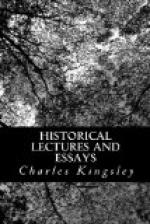Camden has a hearsay story—written, it must be remembered, in James I.’s time—that Buchanan, on his death-bed, repented of his harsh words against Queen Mary; and an old Lady Rosyth is said to have said that when she was young a certain David Buchanan recollected hearing some such words from George Buchanan’s own mouth. Those who will, may read what Ruddiman and Love have said, and oversaid, on both sides of the question: whatever conclusion they come to, it will probably not be that to which George Chalmers comes in his life of Ruddiman: that “Buchanan, like other liars, who, by the repetition of falsehoods are induced to consider the fiction as truth, had so often dwelt with complacency on the forgeries of his Detections, and the figments of his History, that he at length regarded his fictions and his forgeries as most authentic facts.”
At all events his fictions and his forgeries had not paid him in that coin which base men generally consider the only coin worth having, namely, the good things of this life. He left nothing behind him—if at least Dr. Irving has rightly construed the “Testament Dative” which he gives in his appendix—save arrears to the sum of 100 pounds of his Crossraguel pension. We may believe as we choose the story in Mackenzie’s “Scotch Writers” that when he felt himself dying, he asked his servant Young about the state of his funds, and finding he had not enough to bury himself withal, ordered what he had to be given to the poor, and said that if they did not choose to bury him they might let him lie where he was, or cast him in a ditch, the matter was very little to him. He was buried, it seems, at the expense of the city of Edinburgh, in the Greyfriars’ Churchyard—one says in a plain turf grave—among the marble monuments which covered the bones of worse or meaner men; and whether or not the “Throughstone” which, “sunk under the ground in the Greyfriars,” was raised and cleaned by the Council of Edinburgh in 1701, was really George Buchanan’s, the reigning powers troubled themselves little for several generations where he lay.
For Buchanan’s politics were too advanced for his age. Not only Catholic Scotsmen, like Blackwood, Winzet, and Ninian, but Protestants, like Sir Thomas Craig and Sir John Wemyss, could not stomach the “De Jure Regni.” They may have had some reason on their side. In the then anarchic state of Scotland, organisation and unity under a common head may have been more important than the assertion of popular rights. Be that as it may, in 1584, only two years after his death, the Scots Parliament condemned his Dialogue and History as untrue, and commanded all possessors of copies to deliver them up, that they might be purged of “the offensive and extraordinary matters” which they contained. The “De Jure Regni” was again prohibited in Scotland, in 1664, even in manuscript; and in 1683, the whole of Buchanan’s political works had the honour of being burned by the University of Oxford,




